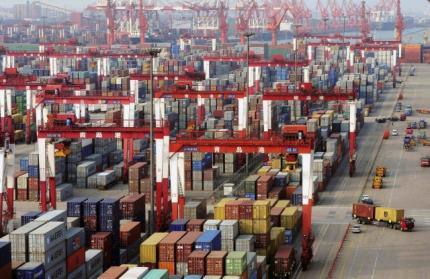Asia exporters not catching typical lift from US recovery
Bareksa • 19 Jun 2014

Trucks drive past piles of shipping containers at the Qingdao port in Qingdao. (REUTERS/China Stringer Network)
Recovery in the West not enough to drive Asia.
Bareksa.com - When the United States sneezes, Asia catches an economic cold, but when it recovers it's a boon for the export-reliant region. That, at least, is how it used to be.
Today, China plays a much greater role in the fortunes of Asian exporters and their economies, trade patterns show.
Exports to China from the likes of South Korea, Taiwan, Malaysia, Thailand, Indonesia and Vietnam all grew between the pre-global-crisis year of 2007 and 2013, while their percentage share of exports to the United States declined over the same period.
That suggests Asia's disappointing and at times erratic export performance over the last year was more reflective of China's economic downshifting and rebalancing than weakness in Western demand, analysts say.
"A recovery in advanced economies should give a tailwind for Asian exports. But if China - the key driver of external demand for the region - lacks momentum, Asian economies could be forced to fly on one engine," said Toru Nishihama, senior economist specialising in emerging markets at Dai-ichi Life Research Institute.
China's economic growth could cool this year to its slowest pace in 24 years, a recent Reuters poll showed.
Since the global financial crisis, China has become increasingly important as the final destination for Asian exports, rather than an "assembly floor", where products are put together and shipped to the United States or Europe.
But as Beijing tries to scale back investment in roads, bridges and airports - seeking to rebalance the economy in favour of stronger consumer demand - imports from its Asian neighbours have been cooling too.
South Korea's annual exports to China fell 9.4 percent in May, the sharpest drop since mid-2009, even as shipments to the United States and Europe rose, while Japan's exports suffered their first annual decline in 15 months, with only a scant gain in sales to China and declines to Western markets.
The International Monetary Fund estimates that a 1 percentage point decline in China's growth may cut growth in the median Asian economy by about 0.3 percentage point after a year, double the impact it would have on average non-Asian economies, underlining China's growing influence on the region.
SUPPLY CHAINS CHANGING
The weakness of China's own exports is also dampening shipments from its Asian neighbours such as Japan or South Korea, which typically supply most of the advanced tech components in China-assembled smartphones, PCs or tablets.
One explanation could be that rising property prices and labour costs, along with a strengthening trend in the yuan, are making China's exports less competitive. That is driving some manufacturers to set up in lower-cost Vietnam, Thailand, Bangladesh or Indonesia, rather than in China.
China is also being challenged by rivals from other continents such as Mexico, whose weakened peso, low wages and proximity give it an edge in the U.S. market.
And while Chinese domestic demand for consumer goods appears to be holding up, much of those are already produced in the country by foreign companies: China today is not only the world's biggest car market but also the top producer.
In other words: Toyota or Hyundai cars sold in China largely do not show up as exports because they are assembled locally.
STRUCTURAL CHANGES
Asian Development Bank Deputy Chief Economist Juzhong Zhuang said this shows how China is adapting and moving its manufacturing sector up the value chain.
"We see a dramatic shift in the composition of manufacturing, from labour intensive towards more sophisticated equipment, mechanical, transport equipment and other mechanics."
Other emerging Asian nations will have no choice but to step up innovation themselves in order to maintain their sales to China.
Analysts say Thailand, which makes a lot of intermediate goods necessary for global output, has more room to grow. Neighbouring Malaysia, which increasingly makes and exports high value-added products such as precision machinery, could also benefit.
Not so the Philippines, which could risk losing market share as Chinese firms grow more sophisticated. It is seen at a disadvantage partly because it exports a lot of lower-end electronics to China.
"China is shifting away from an economy that consumes a lot of resources to one that places emphasis on value-added goods,"
said Kiyoyuki Seguchi, a former Bank of Japan official who is now research director at The Canon Institute for Global Studies.
"For other Asian countries to grow with China, which is becoming an industrialized country, they must have a technological edge that allows them to keep up with China's rising technologies," he said. ($1=6.2175 yuan)
(Source : Reuters)